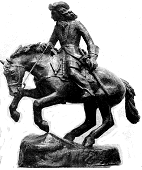
After Cromwell’s conquest of Ireland, more than 40,000 Irish were relocated west beyond the Shannon by the end of 1654. Those who didn’t were press-ganged into the British Navy, or sold as indentured servants to the colonies. There was one group however, who refused to relocate. They eluded capture in the hills and glens near their ancestral homes, and raided the new settlers on the lands of their clans. They led an outlaw existence, and the British called them highwaymen; the Irish called them Rapparees. They were a constant concern to the English as they continued to strike the new owners of the land. In time, a Protestant Parliament invited William of Orange to usurp the English throne of Catholic King James II. James promised religious freedom to those who would support him in defending his crown and many Rapparee’s joined him. After William’s victory at the Battle of the Boyne however, James fled to France leaving his Irish supporters in the field and earning himself the nickname ‘Seamus a Ca Ca’ (translation best left to the reader’s imagination ). Patrick Sarsfield took command of the Irish forces and withdrew to defend the only remaining Gaelic land in Ireland – the portion to which the Irish had been forced by Cromwell years earlier; in hot pursuit was William’s vastly superior army. Sarsfield decided to make a stand at the walled city of Limerick, but he needed help, and he turned to the local Rapparees. There were at least 5 different bands of Rapparees controlling the glens and mountains around Limerick, but the Rapparee who was to ride into history with Sarsfield was Michael “galloping” Hogan, who controlled the mountains of Tipperary and Clare, southwest of Nenagh.
Meanwhile, King William’s forces reached Limerick on August 9, 1690 ahead of his artillery. His demand for surrender was refused, and an assault on the town was repelled. He bellowed for his artillery which, he was informed, was on its way from Cashel in Tipperary. Hogan’s riders, who had been scouting the massive siege train, confirmed it was the largest collection of artillery ever to enter Ireland – 153 wagons drawn by 400 horses. Hogan proposed a daring plan. He would lead Sarsfield and a detachment of 500 men out of Limerick under cover of night, travel north along the Clare side of the Shannon to a point where men could cross with ease, and attack William’s siege train from the rear. Sarsfield agreed, and Hogan led the detachment to a point on the north edge of Killaloe where the Shannon was so narrow and shallow that it was once used by eastern clans to drive their cattle tribute across to High King Brian Boru’s fortress of Kincora at Killaloe. Sarsfield’s men easily crossed into Ballina, Tipperary and began south toward Ballyneety, where the siege train was camped for the night. Meanwhile, one of Hogan’s men, left behind to shoe his horse, met the wife of a Williamite soldier heading for the English camp. From her he learned the password of the enemy camp. Ironically, it was Sarsfield!
Hogan led Sarsfield to the edge of the English camp. Sentries, who accepted the password when they challenged the approaching shadows, were dead before they hit the ground. The Irish swarmed into the camp, and dispatched the enemy. Sarsfield ordered the guns into a circle, muzzles inward. They were filled with gunpowder and the muzzles driven into the ground. The remaining shells, powder and supplies were put in the middle of the circle, and a powder trail laid to the edge of the woods. The troops were ordered into the wood, and Hogan was given the honor of putting a match to the powder. The resulting explosion on August 11, shook the earth with the loudest man made sound ever heard in Ireland, and lit up the sky with a flash that was seen from the walls of Limerick City.
Without his artillery, William realized that he could not take Limerick, so on August 29 he offered terms to the Irish. Those who had fought in James’s army would have to leave Ireland, but their families who stayed behind would get their lands back and the free practice of their religion. After a month of negotiation, the terms were accepted, and the treaty of Limerick was signed on October 3, 1691. True to its terms, 14,000 Irish left Ireland, and among them Patrick Sarsfield and the Galloping Hogan. The Flight of the Wild Geese had begun. They would distinguish themselves in the Irish Brigades of foreign armies, but they never saw Ireland again. As for those left behind, they never saw the promises of the Treaty fulfilled. In 1692 Lord Sydney called a Parliament in Dublin which was dissolved in 1693. In 1695, Lord Capel was appointed Lord Lieutenant and called a new parliament which introduced the Penal Laws now that the threat of Irish retribution was gone. The last parts of the Treaty were officially broken by the Popery Act which denied the existence of an Irish Catholic and any rights they might have.
However, today many memorials exist to that time in Irish history, the most notable of which is the road along the Shannon River between Limerick and Killaloe. It is called Sarsfield’s Ride, but there are many who think it should be called the Hogan Highway, after that superb horseman and early guerilla fighter – the Galloping Hogan.